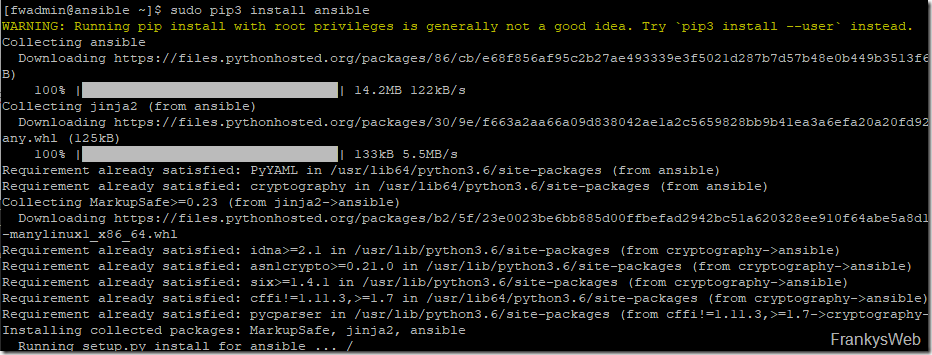
Pip3 install ansible how to#
This section shows how to create a test resource group within your new Ansible configuration.

You now have a virtual machine with Ansible installed and configured! On the host virtual machine, export the service principal values to configure your Ansible credentials. Option 2: Define Ansible environment variables Replace the placeholders with the service principal values. Insert the following lines into the file. Once you've successfully connected to the host virtual machine, create and open a file named credentials: mkdir ~/.azure For security reasons, credential files should only be used in development environments.įor more information about defining Ansible credentials, see Providing Credentials to Azure Modules. In this section, you create a local credentials file to provide credentials to Ansible. Option 1: Create Ansible credentials file

Option 1: Create an Ansible credentials file.

Pip3 install ansible update#
# Update all packages that have available updates. Run the following commands to configure Ansible 2.9 on Centos: #!/bin/bash Install Ansible on the virtual machine Ansible 2.9 with the azure_rm module ssh the with the appropriate value returned in previous commands. Using the SSH command, connect to your virtual machine's public IP address. (Get-AzVM -ResourceGroupName QuickstartAnsible-rg QuickstartAnsible-vm-pwsh | Get-AzPublicIpAddress).IpAddress pip : name : bottle executable : pip-3.Az vm show -d -g QuickstartAnsible-rg -n QuickstartAnsible-vm -query publicIps -o tsv pip : requirements : /my_app/requirements.txt extra_args : -i # Install (Bottle) for Python 3.3 specifically,using the 'pip-3.3' executable. pip : requirements : /my_app/requirements.txt virtualenv : /my_app/venv # Install specified python requirements and custom Index URL. pip : requirements : /my_app/requirements.txt # Install specified python requirements in indicated (virtualenv). pip : name : git+ editable : false # Install (MyApp) from local tarball - pip : name : file:///path/to/ # Install (Bottle) into the specified (virtualenv), inheriting none of the globally installed modules - pip : name : bottle virtualenv : /my_app/venv # Install (Bottle) into the specified (virtualenv), inheriting globally installed modules - pip : name : bottle virtualenv : /my_app/venv virtualenv_site_packages : yes # Install (Bottle) into the specified (virtualenv), using Python 2.7 - pip : name : bottle virtualenv : /my_app/venv virtualenv_command : virtualenv-2.7 # Install specified python requirements. pip : name : svn+ # Install MyApp using one of the remote protocols (bzr+,hg+,git+) in a non editable way. You do not have to supply '-e' option in extra_args. pip : name : bottle version : 0.11 # Install (MyApp) using one of the remote protocols (bzr+,hg+,git+,svn+). pip : name : bottle # Install (Bottle) python package on version 0.11.


 0 kommentar(er)
0 kommentar(er)
